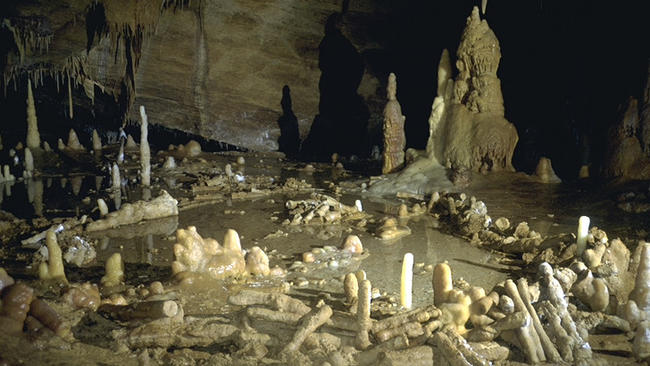Neanderthals has always been considered as not so smart hominid destined to be replaced through natural selection by us, smart Homo sapiens.
But the new discovery from a cave in France should make us think again about lack of smartness of our distant cousins.
Deep in a dark cave in southwestern France lie half a dozen mysterious structures that scientists believe were built by Neanderthals 176,000 years ago — about 140,000 years before the first modern humans arrived in Europe.
The structures, described Wednesday in the journal Nature, are located in what is known as the Bruniquel Cave. They are made of roughly 400 pieces of stalagmites, all roughly, almost eerily, the same size.
Archaeologists say these mineral formations were probably broken off the cave floor by ancient hands and then deliberately arranged into two large rings and a series of four round piles up to 15 inches high.

Archaeologists say the circular structures discovered deep in a cave in southwestern France were constructed by Neanderthals 176,000 years ago. (Etienne Fabre / SSAC)
It it seems the structure was used for some ritualistic behaviour. That implies a high level of social development in community that created it.
And perhaps most intriguingly, the study authors say that the group responsible for the mysterious construction must have had a fairly sophisticated social structure.
“Building these structures was a project. It required an objective which has been discussed among several people and enough social organization to assign tasks,” said Jacques Jaubert of the University of Bordeaux in France and the first author on the study. “Certainly, it was a collective work.”
William Rendu, an archaeologist with the French National Center for Scientific Research, who was not involved in the research, said the peculiar arrangement of broken stalagmites, as well as their association with fire, makes it clear that the structures could only have been made by early humans, and not by bears or other animals that probably also used the cave.

A 3-D reconstruction of the structures in the Bruniquel Cave. (Xavier Muth / Get in Situ, Archéotransfert, Archéovision -SHS-3D)
Neanderthals lived in Eurasia from around 400,000 to 40,000 years ago. But we hardly know anything about how they lived.
Interesting thing about this discovery is use of modern methods in dating. This finding also underlines how important preservation is.
Marie Soressi, an archaeologist at the Leiden University in the Netherlands, explained that part of what makes the finding so thrilling is how the chemistry of the cave ensured that the assemblages were preserved over so many millennia. These structures are among the best-preserved constructions known for the whole of the Pleistocene epoch, probably because they were sealed by calcite very soon after they were erected,” she wrote.
The first academic study on the cave was published in 1996 and included a detailed plan of the structures, as well as a single carbon date taken from a burned piece of bone found in the larger of the two ring structures. That particular dating technology suggested it was at least 47,600 years old, but was not capable of looking deeper into the past.
This time around, they dated seven stalagmites from the two ring structures using a method called uranium series dating. By sampling the calcite that had grown both before and after the stalagmite fragments were broken, the researchers could constrain the dates when the structures were built to roughly 176,000 years, give or take 2,000 years.
This cave is re-writing the history of Neanderthals. It seems our cousins went extinct not because of less smartness, but more because extreme climatic changes.

It seems our cousins went extinct not because of less smartness, but more because extreme climatic changes.
Quite possibly exacerbated by our N-great-grandparents.
176,000 yrs. That just totally blows my mind.
It seems our cousins went extinct not because of less smartness, but more because extreme climatic changes.
I don’t see what climate change would kill them off and not kill off the humans.
Marcus, do we know the local homo sapiens weren’t killed off as well? Later ones could have come from elsewhere if they had a wider range.
Neanderthals were humans too. But moderns did have at least one advantage in cold adaptation – the invention of the sewing needle, that allowed the making of better clothing. (Though Neanderthals had better physical adaptations to cold.)
robertbaden: do we know the local homo sapiens weren’t killed off as well?
I have no idea!
It seems suspicious to me that weather wiped out all the neanderthals worldwide, though.
I don’t think the cold could have wiped them out on its own. They had survived previous cold periods. But if another human population was competing with them for resources and said population had even a slight technological edge that could have done the job.
We know that moderns spread to places few Neanderthals got to such as Siberia.
Also, another hypothesis was that Neanderthals had higher rates of death in childbirth due to their larger heads. Not sure where this one stands these days.
Jeebus – stalagmites are migratory…
I read that Neanderthals had been more assimilated and interbred with population of people moving in from Africa; the article (in National Geographic) said that today people of European or Asian descent have anywhere from 1% – 4% Neanderthal DNA.
This is an amazing discovery. 176,000 years!